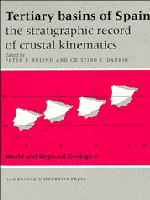Book contents
- Frontmatter
- Contents
- List of contributors
- Preface
- Dedication to Professor Oriol Riba IArderiu
- Memorial, Etienne Moissenet 1941–1994
- PART G GENERAL
- PART E EAST
- PART W WEST
- PART C CENTRE
- PART S SOUTH
- S1 The Betic Neogene basins: introduction
- S2 Neogene palaeogeography of the Betic Cordillera: an attempt at reconstruction
- S3 Depositional model of the Guadalquivir – Gulf of Cadiz Tertiary basin
- S4 Late Neogene depositional sequences in the foreland basin of Guadalquivir (SW Spain)
- S5 Miocene basins of the eastern Prebetic Zone: some tectono sedimentary aspects
- S6 Stratigraphic architecture of the Neogene basins in the central sector of the Betic Cordillera (Spain): tectonic control and base-level changes
- S7 Pliocene–Pleistocene continental infilling of the Granada and Guadix basins (Betic Cordillera, Spain): the influence of allocyclic and autocyclic processes on the resultant stratigraphic organization
- S8 Late Neogene basins evolving in the Eastern Betic transcurrent fault zone: an illustrated review
- S9 Tectonic signals in the Messinian stratigraphy of the Sorbas basin (Almeria, SE Spaín)
- S10 Basinwide interpretation of seismic data in the Alborán Sea
- Index
S5 - Miocene basins of the eastern Prebetic Zone: some tectono sedimentary aspects
Published online by Cambridge University Press: 04 August 2010
- Frontmatter
- Contents
- List of contributors
- Preface
- Dedication to Professor Oriol Riba IArderiu
- Memorial, Etienne Moissenet 1941–1994
- PART G GENERAL
- PART E EAST
- PART W WEST
- PART C CENTRE
- PART S SOUTH
- S1 The Betic Neogene basins: introduction
- S2 Neogene palaeogeography of the Betic Cordillera: an attempt at reconstruction
- S3 Depositional model of the Guadalquivir – Gulf of Cadiz Tertiary basin
- S4 Late Neogene depositional sequences in the foreland basin of Guadalquivir (SW Spain)
- S5 Miocene basins of the eastern Prebetic Zone: some tectono sedimentary aspects
- S6 Stratigraphic architecture of the Neogene basins in the central sector of the Betic Cordillera (Spain): tectonic control and base-level changes
- S7 Pliocene–Pleistocene continental infilling of the Granada and Guadix basins (Betic Cordillera, Spain): the influence of allocyclic and autocyclic processes on the resultant stratigraphic organization
- S8 Late Neogene basins evolving in the Eastern Betic transcurrent fault zone: an illustrated review
- S9 Tectonic signals in the Messinian stratigraphy of the Sorbas basin (Almeria, SE Spaín)
- S10 Basinwide interpretation of seismic data in the Alborán Sea
- Index
Summary
Abstract
The Miocene series of the eastern Prebetic domain include Aquitanian to early Tortonian marine deposits and a late Tortonian to Messinian–Early Pliocene continental sequence. These deposits are contemporaneous with different episodes of folding and faulting related to the variations of the compressional axis, between N–S and NW–SE. Numerous unconformities and synsedimentary or sealed structures illustrate the different stages of development of Miocene synorogenic basins and give an accurate chronology of the tectonic history of the eastern part of the External Betic Cordilleras.
Introduction
The eastern Betic Cordilleras include three major geological domains, from the North to the South (Fig. 1A): 1. the Prebetic autochthonous domain; 2. the Subbetic allochthonous units, overthrusting northwards the Prebetic domain; Prebetic and Subbetic are referred to as the external zone of the Betic Cordilleras; and 3. the internal allochthonous zone composed of a pile of alpine nappes, including sedimentary and various metamorphic rocks; this domain is separated from the external zone by a major ENEWSW-trending wrench-fault corridor (the North Betic wrench fault).
This study is dedicated to the Miocene basins evolving in the eastern part of the Prebetic domain (Fig. 2).
The eastern segment of the Prebetic domain is a folded ENE–WSW-trending zone. The folds are elongated structures often faulted and thrusted northwards. Some minor fold axes are twisted with a NE–;SW to N–S orientation. NE–SW faults have recorded sinistral or reverse-sinistral movements. NW–SE faults cut through the folds; they acted as normal faults, often reactivated with dextral movement.
- Type
- Chapter
- Information
- Tertiary Basins of SpainThe Stratigraphic Record of Crustal Kinematics, pp. 346 - 352Publisher: Cambridge University PressPrint publication year: 1996
- 2
- Cited by



